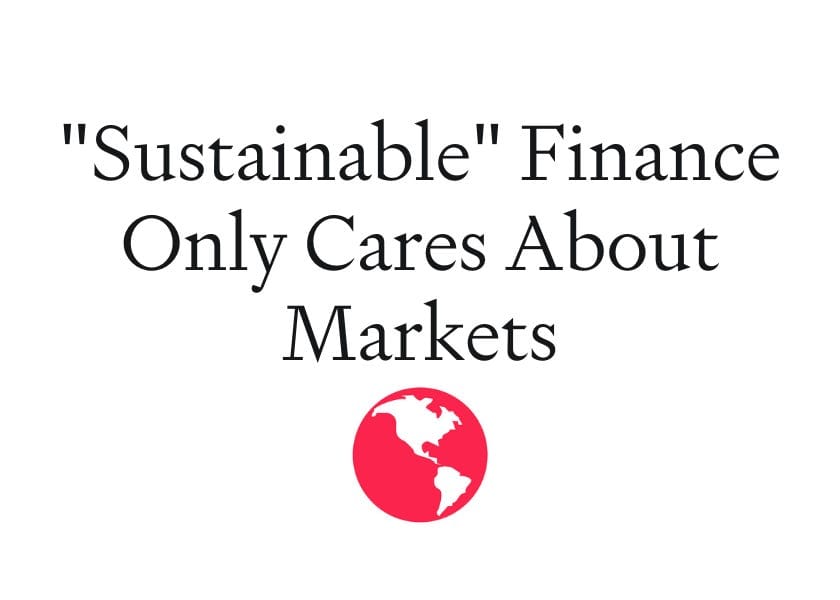"Sustainable" Finance Only Cares About Markets
First they came for the treetops, then everything living below

On last week’s episode, I spoke with Frederic Hache, the co-founder and executive director of the Green Finance Observatory, an NGO tracking the world of “sustainable finance”, debunking its claims, and working with European policymakers to warn against supposed market-based solutions. The GFO is trying to stop the revolution of green finance, which they fear will continue business as usual and allow the powerful to profiteer from the climate crisis.
He explained the typical mechanisms of green finance: the claims, the schemes, the plots, from carbon credits to biodiversity offsetting to water pollution credits, giving a fantastic overview of how governments around the world are handing environmental protection over to market based solutions.
Let’s take the most prevalent example of green finance: the carbon credit market, which facilitates “carbon offsetting”. The idea is a polluting company or nation buys “carbon credits”, paying for the protection of a forest or peat land where carbon is sequestered—stored—which then counts as offsetting, or cancelling out, their own carbon emissions. Net Zero nonsense is built around this mechanism—despite the fact that any emissions contribute to global warming. This market hands over the right to pollute to the wealthiest whilst putting those on the frontline of the climate crisis at risk from increasingly dangerous weather events. Welcome to capitalism.
But this isn’t the only way such markets put vulnerable communities at risk. Fred explains these schemes have been linked to human rights abuses and land grabs—indigenous people around the world are being forcibly displaced from their historic homes, forests they have stewarded for generations, in order to put those forests on this market all in the name of climate change prevention.
The nightmare logic continues when one understands that by doing so, governments are proclaiming that forests are only good for one thing: storing carbon. This dystopian reduction extinguishes the richness of the natural world; biodiversity, animals, plants, ecosystems, beauty. This isn’t about protecting the natural world. It’s about creating a market.
Land is being taken away from the very people who protect it to be put on a market which has no interest in its genuine riches. And at the same time as the market is allegedly protecting forests around the world, the logging industry continues to rape our most ancient and pristine forests all over South East Asia, the Pacific, Europe—even Siberia. This logging is causing terrible flooding and huge destruction, its causing endangered species to lose their territory, indigenous people to lose their culture, their homes, their ability to feed themselves. All in the name of, what, IKEA furniture?
For both things to happen at the same time only confirms the market-based solutions offered thus far are not about protecting the environment, they are about profiteering off of the crisis. It’s about finding yet another way to commodify the natural world.
The cognitive dissonance is astounding—so much so, it reveals the agenda. We are cutting down forests, which is contributing to climate change in order to have access to a commodity which we can turn into products, whilst at the same time allegedly saving other forests in the name of climate change because we need to sequester our carbon emissions and forests are an excellent way of doing so.
The equation is obvious: stop cutting down forests to reduce the impacts of climate change. But the financial markets have hijacked that equation to add in extra step, making it utterly illogical but equally profitable.
Fred then goes on to explain the biodiversity offset market, the framework for which the European commission is currently drafting and trying to push through. The UK government is doing the same. The UN is expected to announce it at the next Cop. Essentially, a biodiversity offset market is the ability to financialise the destruction of nature, and conflate restoration with destruction.
This means companies and governments will be able to destroy habitats and ecosystems and valuable spaces, natural spaces, which are incredibly important to species, by buying biodiversity credits. It will be acceptable—perhaps encouraged—to destroy the habitat of a species as long as the developer purchases the arbitrary financial value of that species habitat in credits. That money then goes towards either restoring that particular habitat or restoring another elsewhere: You can kill flamingos in Spain if you’re saving bats in Greece.
Not only does this reduce living things to financial values, it also negates science, treating habitats as if they are interchangeable, as if ecosystems exist in separate silos and are not an intrinsic part of their own wider environment. It’s madness.
First they came for the treetops, then they came for everything living below.
At what point will every part of our own existence be tokenised? Fred mentioned plans for water pollution credits, for air pollution credits. It doesn’t take a stretch of the imagination to imagine human health credits, couched in labour law: that companies will be allowed to put the lives of their workers at risk as long as they’ve bought the financial value of those lives in credits, which can then be invested in medicine research, for example.
If we continue to allow the financialisation of every single living thing on this planet, then we will find ourselves equally financialised, reduced to numbers. We’re almost there already: our education's been financialised, our shelter, our health, our socialisation.
We have to be aware of the implications of offsetting and what the wider trend could impact. The GFO is desperately trying to raise awareness in public discourse of the extent of financial greenwashing, and highlight that not only does it have no history of working, we already have the solutions. Environmental regulations have a long history of being extremely effective. It’s how we tackled asbestos, and the ozone layer. It’s why national parks are protected.
Why, when we have mechanisms with effective historical precedent, are governments turning to the market for help?
Capital flows through the path of least resistance; the market would respond to environmental regulations. Clearly, today’s path of least resistance takes the form of our political leaders.
Planet: Critical investigates why the world is in crisis—and what to do about it.



